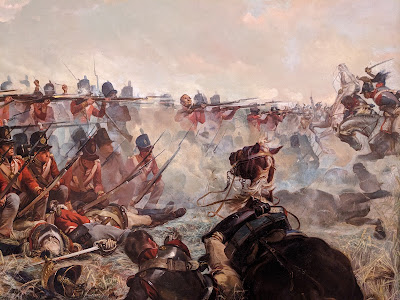I'm still painting the latest batch of galleys (and it will probably be a week or so at least before they see any action, but I did have a play with my existing ones yesterday. I wanted to try out some alternative stats for ancient galleys I'd been thinking about whilst we were away over the weekend.
The aim was to simplify the stats given in the rules and tweak the quality of the galleys so that some of the larger ones would be more useful. At present the quinquereme, which seems to have been a mainstay of some fleets, seems somewhat underwhelming compared to the trireme, because it has a Quality of 4, making a group of them quite hard to activate without a flagship to boost them. There's also a strange quirk of the quadreme where it seems to have been given the reinforced hull trait in order to have it sit uneasily between the trireme and the quinquereme in terms of ability to give and receive attacks.
What I decided to do was drop the C values on some types, leave others as they were and try to improve quality on some larger ships.
My proposed stats (including ships I'm not ready to field yet) are:
Bireme - Q2 C1 - Ramming, Unarmed, Yare, Shallow Draft
Trireme - Q3 C2 - Ramming, Unarmed, Yare, Shallow Draft
Quadreme - Q3 C3 - Ramming
Quinquereme - Q3 C4 - Ramming
Hexareme - Q4 C5 - Ramming, High Towers
I set up two sides, nominally Carthage (Red) and Syracuse (Blue), and gave each three quinqueremes and four triremes. There were no flagships, but with everything operating with a Q3 that shouldn't be an issue.
Here's the action after a few moves, with the quinqueremes of both sides in the centre, and triremes operating on the flanks.
The first attack saw a Carthaginian trireme get ahead of its main force and get rammed by a Syracusan trireme.
A bad roll on the All At Sea table saw the Carthaginian vessel ground itself on the island, and sink. The Syracusan triremes then fell back to cover the flanks of their larger ships.
North of the island two Carthaginian ships closed in on a lone Syracusan trireme.
The quinqueremes were closing up now as well. Unlike the triremes they have deck artillery, and the Carthaginians soon started taking hits.
Indeed one was sunk rather quickly, and the Syracusans closed up to bring their newly gained fire superiority to bear at closer range.
Meanwhile near the island a Carthaginian trireme had been sunk, and another was forced to strike as a second Syracusan trireme joined the action.
A Carthaginian quinquereme caught fire. With galley actions I remove the possibility of explosions, however; any explosion result is simply treated as an additional fire (which pretty much dooms the vessel anyway, but not so immediately).
The end of the action - the Carthaginians had lost a couple of ships sunk, one surrendered and one burned beyond salvage. Syracuse had a trireme surrender, but had otherwise just taken damage.
The new stats seemed OK, but there is the danger that they make the artillery maybe too good, so I'd have to try them out some more.
To be fair I ran a second game using the stats in the rules. Whilst the quinqueremes had their moments failing to activate they still proved useful and weren't too outclassed by the triremes. I need to play more games.


















































